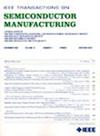DPFEE-Net: Enhancing Wafer Defect Classification Through Dual-Path Neural Architecture
IF 2.3
3区 工程技术
Q2 ENGINEERING, ELECTRICAL & ELECTRONIC
引用次数: 0
Abstract
Wafer defect detection and classification are essential for ensuring the quality of semiconductor wafers, optimizing production efficiency. However, existing methods often fail to process shallow and deep feature information concurrently, restricting their capacity to utilize multi-level features for accurate classification. To overcome this limitation, this paper introduces a novel dual-path architecture, DPFEE-Net, which integrates PeleeNet’s dense connection structure and multi-channel feature fusion techniques with the deep feature extraction capabilities of Convolutional Neural Networks (CNNs). By combining these two approaches, DPFEE-Net effectively captures both shallow and deep features, enhancing the detection of critical wafer surface defect patterns. Additionally, squeeze-and-excitation (SE) attention mechanism is incorporated, enabling the model to prioritize defect-prone areas in images, further improving classification accuracy. Experimental results demonstrate that DPFEE-Net achieves a remarkable average accuracy of 96.8% on the WM-811K dataset, surpassing existing methods such as WM-PeleeNet, WDD-SCA and MobileNetV2. Moreover, the model delivers superior detection performance with reduced computational complexity and parameter requirements, making it highly suitable for practical deployment in production environments.DPFEE-Net:通过双路神经网络架构增强晶圆缺陷分类
晶圆缺陷检测与分类是保证半导体晶圆质量、优化生产效率的关键。然而,现有方法往往不能同时处理浅层和深层特征信息,限制了其利用多层次特征进行准确分类的能力。为了克服这一限制,本文引入了一种新的双路径架构DPFEE-Net,它将PeleeNet的密集连接结构和多通道特征融合技术与卷积神经网络(cnn)的深度特征提取能力相结合。通过结合这两种方法,DPFEE-Net有效地捕获了浅层和深层特征,增强了对关键晶圆表面缺陷模式的检测。此外,该模型还引入了挤压-激发(squeeze-and-excitation, SE)注意机制,使模型能够优先考虑图像中容易出现缺陷的区域,进一步提高了分类精度。实验结果表明,DPFEE-Net在WM-811K数据集上的平均准确率达到96.8%,超过了现有的WM-PeleeNet、WDD-SCA和MobileNetV2等方法。此外,该模型提供了卓越的检测性能,降低了计算复杂度和参数要求,使其非常适合在生产环境中实际部署。
本文章由计算机程序翻译,如有差异,请以英文原文为准。
求助全文
约1分钟内获得全文
求助全文
来源期刊

IEEE Transactions on Semiconductor Manufacturing
工程技术-工程:电子与电气
CiteScore
5.20
自引率
11.10%
发文量
101
审稿时长
3.3 months
期刊介绍:
The IEEE Transactions on Semiconductor Manufacturing addresses the challenging problems of manufacturing complex microelectronic components, especially very large scale integrated circuits (VLSI). Manufacturing these products requires precision micropatterning, precise control of materials properties, ultraclean work environments, and complex interactions of chemical, physical, electrical and mechanical processes.
 求助内容:
求助内容: 应助结果提醒方式:
应助结果提醒方式:


